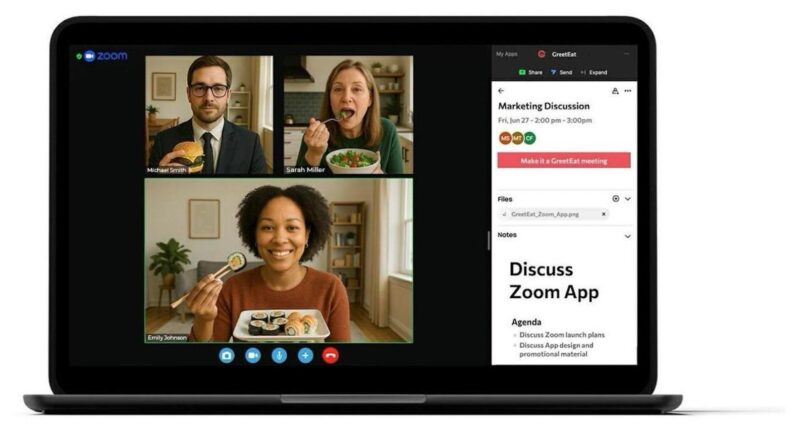Share this @internewscast.com
At the height of the pandemic, Vishal Patel noticed a shift in his workday. Meetings hadn’t stopped— they’d multiplied. But the shared meals, coffee breaks, and casual conversations that once brought people together had quietly disappeared.
“People were still meeting,” he said. “But they weren’t connecting.”
With a background in tech, communications and a lifelong interest in logistics, Patel saw an opportunity: what if the social glue of shared meals could be brought back—virtually?
That insight sparked the creation of GreetEat (OTC: GEAT), a startup he now leads as chief executive. The platform, which quietly rolled out across the U.S. and Canada after a beta launch, lets users attach meal vouchers to virtual meetings, delivered through Uber Eats. Attendees receive a credit before a video call, order their food from a local restaurant, and log in to join a meeting where everyone is sharing a meal— together, apart.
“Our biggest advantage? Billing goes straight to the HR department. The employee doesn’t need to worry about receipts or reimbursements— it’s all taken care of,” says Patel.
It’s not just a feel-good idea. As Patel sees it, it’s a fix for one of remote work’s most persistent flaws.
“People are working longer hours and attending more meetings, but they’re more isolated than ever,” he said. “Food has always been a cultural equalizer. We’re just making it logistically possible again.”
GreetEat allows users to attach Uber Eats meal vouchers to virtual meetings, giving attendees a … More
GreetEat
Remote Workers can now share meals
From catered team brainstorms to donuts in the break room, meals are an unspoken but impactful part of on-site corporate culture. But in the era of hybrid and fully remote work, that has all but disappeared. What’s replaced it— scheduled video calls— often feel sterile. “It’s significantly more difficult to establish trust in virtual environments,” write Mark Mortensen and Heidi K. Gardner in Harvard Business Review.
“The transition to remote work has resulted in a critical gap: virtual meetings lack the human touch that shared meals bring,” says Patel. “Our vision is to merge technology and hospitality to recreate the joy of dining together, no matter the distance.”
Patel is betting that food can help close the social gap in remote work— and he’s not alone. ChefPassport and KraftyLab launched in 2018 and 2017, respectively, offering virtual cooking classes and food-based team events. And other companies have experimented with meal stipends and virtual happy hours to rebuild cohesion. But these efforts are typically piecemeal, lacking a streamlined way to host meetings and integrate food. Most fall apart under logistical challenges: coordinating orders, managing reimbursements, dealing with receipts.
GreetEat tries to solve that with a single interface. The platform integrates video conferencing with on-demand food delivery, allowing hosts to attach meal vouchers to virtual meetings. Participants order from local restaurants, and Uber Eats handles real-time delivery through its global network. The entire process— from scheduling to tracking and reconciliation— is managed seamlessly within one system.
“This is a transformational leap forward for remote engagement,” says Patel. “By joining forces with Uber Eats, we’ve eliminated borders, bottlenecks, and logistical friction. Now, companies can create rich, shared experiences that foster connection, culture, and community at scale.”
For now, the platform operates on a subscription model for businesses, with GreetEat earning a fee per transaction through its Uber Eats integration. Additional partnerships with DoorDash, Grubhub, and other services are in the pipeline, as are integrations with HR platforms like Workday and SAP, and gaming platforms such as Steam, PlayStation and Xbox.
More than just meals
GreetEat targets office workers— the millions now tethered to screens. According to 2025 data from Gallup, 80% of remote-capable employees work fully or partially from home. Zoom alone hosts 350 million daily participants and logs over 3.3 trillion meeting minutes annually. More than half of fully remote leaders spend at least three hours a day in virtual meetings. That’s alot of missed, hurried and isolated meals.
And GreetEat’s potential extends well beyond the typical team lunch. A tech company might use it for virtual onboarding, allowing new hires to select a meal before joining their first team meeting. A design agency could incorporate it into client pitch sessions, creating a more engaging and hospitable experience. An e-sports organization could adapt the platform to reward players with food deliveries after hitting key milestones during marathon tournaments.
“Remote work didn’t eliminate food,” Patel said. “It just eliminated the context where we used to share it.”
Shared meals and remote work culture
Vishal Patel, Founder and CEO of GreetEat
GreetEat
In a world where companies offer allowances for everything from mental health apps to standing desks, Patel thinks food deserves the same status— not as a perk, but as a core driver of productivity.
“There’s a budget line for productivity tools, another for wellness,” he said. “Food cuts across both. It makes people show up.”
And he might just be right. A recent ezCater report found that 53% of employees feel more productive when their employer provides free food, and 42% say it also improves the quality of their work. The impact goes beyond convenience— nearly a third of workers don’t take time away from their desks to eat, a habit that can contribute to burnout and reduced performance.
Whether companies agree remains to be seen. GreetEat is still early-stage. What’s clear is that GreetEat is attempting to formalize a part of work culture that had, until now, gone largely unaddressed.
And according to Patel, early adopters are seeing strong results: meetings with GreetEat vouchers show attendance increases of up to 60%, along with higher engagement and satisfaction. Companies also report reduced HR burdens tied to expense tracking and reimbursements. As a bonus, integrated virtual dining is proving to be a valuable recruitment and retention tool— especially among younger, remote-first workers who prioritize flexibility and lifestyle benefits.
At its core is a simple proposition: that people still want to eat together, even when they’re apart— and that shared meals, however digitally reconstructed, still matter. “We didn’t invent anything new,” Patel said. “We just tried to remove the friction from something very old.”











